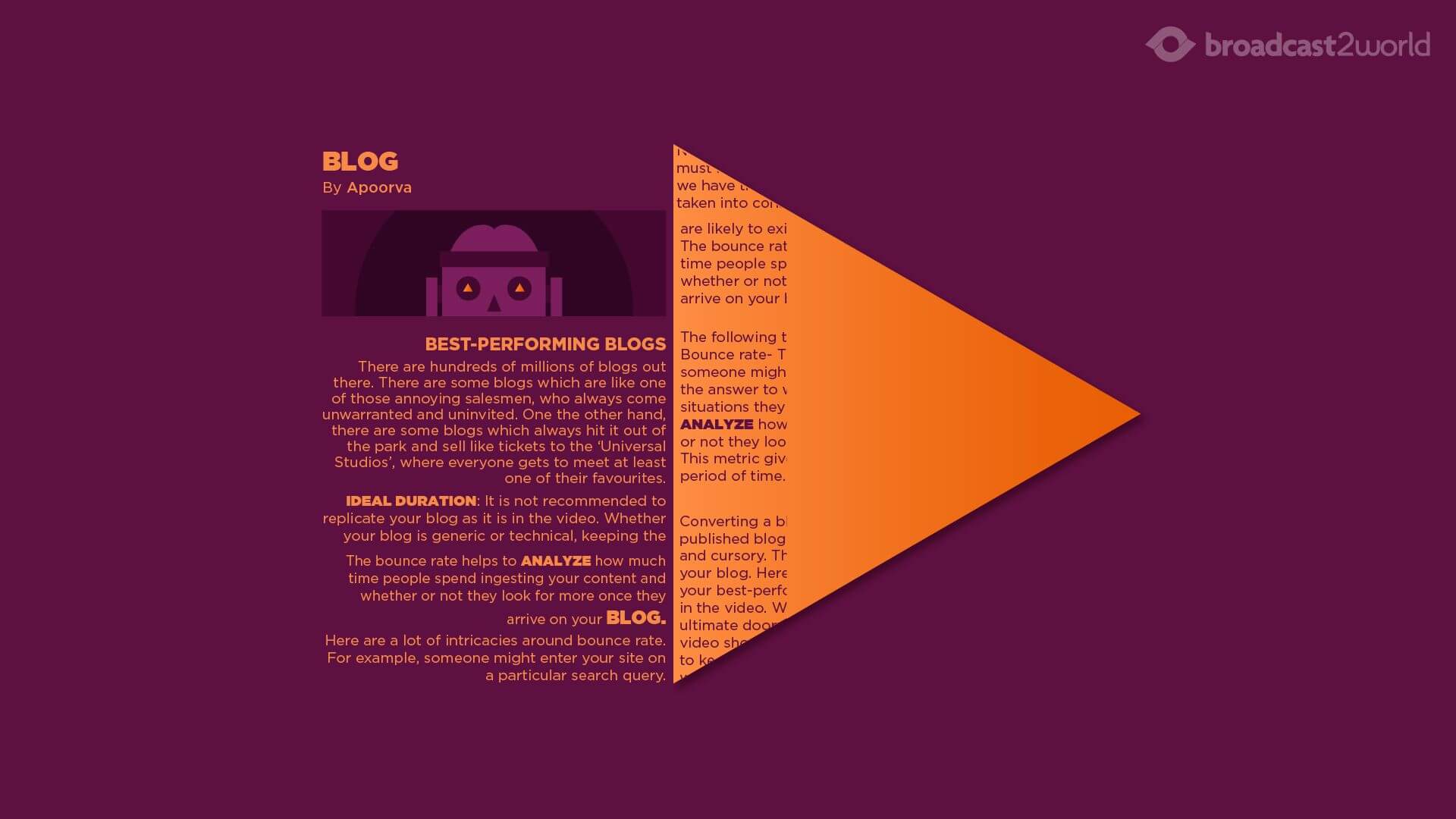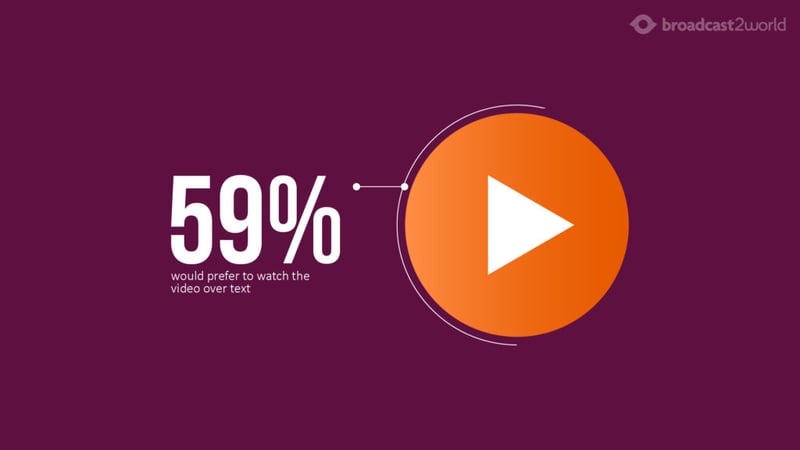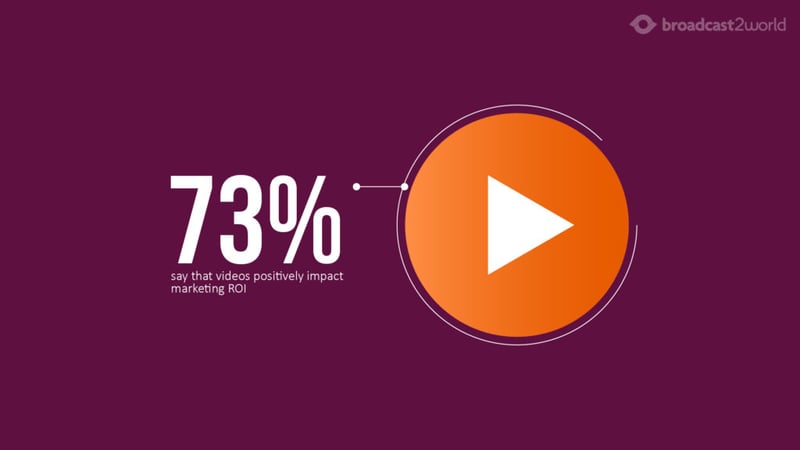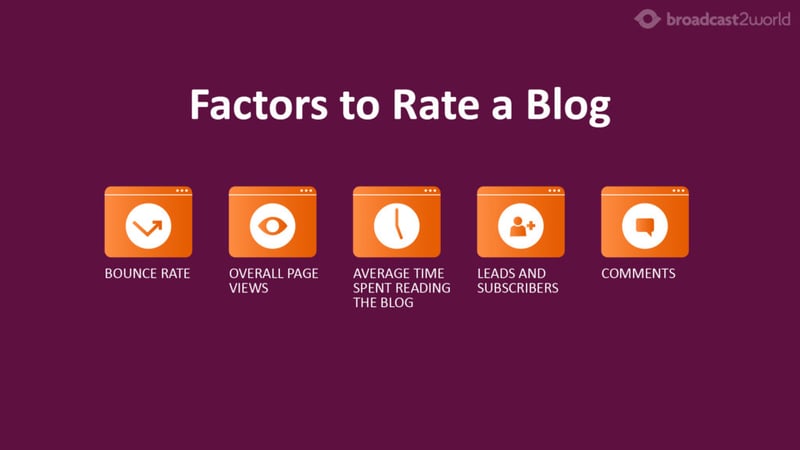
Well, in this 21st century, when content can be created and distributed at a lightning speed, not all content will be read. While your blog content might draw eyes to your website, it can’t keep people glued there by itself.
When more blog traffic and conversions are the end goals that your business wishes to achieve, your content needs to have a strong foothold.
But, this would be a far-fetched dream if your content were to perform alone. Now, what comes in the picture is the sheer love that Google has for videos.
Publishing a blog with a video header would mean that even if your blog is pushed back into the forgotten lands, your video will still rank high in Google and attract a lot of relevant eyeballs to your website.
Here’s a quick fact to support our stance- 59% of senior executives agree that if both text and video are available on the same topic, they would prefer to watch the video.
To top it up, 73% of B2B marketers say that videos positively impact marketing ROI


Not just these numbers, but a whole lot of SEO logic goes behind the idea of converting blogs into animated educational videos: The accessibility and immersion of a video mean that people spend a long time watching video content that you produce.
If your video is truly captivating, people will spend more time on your webpage where the video is published. This, in turn, increases what is called the dwell time.
The more dwell time you have, the better your pages will be ranked on Google.
But, before you’d like to move forward, there might be a lot of questions that would have cropped up in your mind. Let us look at them one by one!
Choosing the best performing blog from a pool of countless blogs could be very strenuous and laborsome.
There are a lot of subjective factors that come into play when it comes to deciding which among all your blogs is the star performer.
Now, that is our vote: The decision of choosing the best performing blog must not be subjective. It should rather be objectively driven. Here’s how we have tried to crack this code for you. The following things must be taken into consideration while rating a blog:

There are a lot of intricacies around bounce rate. For example, someone might enter your site on a particular search query.
If they quickly find their answer or even if they don't, either way, they'll soon wander off to other areas of the internet and exit your page. This would mean that your goals to achieve higher traffic and conversions could go for a toss.
So, the bounce rate is helpful in analyzing how much time people spend ingesting your content and whether or not they look for more once they arrive on your blog.
This metric gives you the number of visits that your blog has had for a given period of time. In simple words, this is the traffic that comes on your blog page.
It might seem to be a very basic metric, but it happens to be the most quintessential measure to track how your blogs could influence your conversions.
Closely intertwined with overall page views is the number of inbound links on your blog post.
Inbound links are an extremely valuable currency in the land of search engines. It can be quite interesting to take a look at what conversations you are inspiring elsewhere on the web.
Most individuals today are time-constrained and they want to jump down to the key takeaways as quickly as possible.
In such a situation, being able to grab your readers’ attention for long means that your content is immersive.
So, your content must be designed in such a way that your readers want to stay on your content and act on it for as long a duration as possible.
Traffic is all well and good, but leads and subscribers are a much better indicator of your blog’s impact on building the right online community for your business.
When you start tracking how well your blog is contributing to lead generation, crucial correlation can be established between variables such as content volume, content type, frequency and lead generation effectiveness.
Well, at the end of the day, all businesses aspire to have the maximum outreach in such a manner that right energies get attracted back.
The number of comments is an excellent metric to track engagement and readers’ sentiments on your blog. If engagement on your content is low, the following measures must be taken to encourage comments-
When readers feel more engaged with your content, they are more likely to come back in the future, share your posts with others and help you expand your reach.
Now, it is important to highlight that not only the five parameters mentioned above, but a lot of other factors have an important bearing in deciding the star performer among your blogs.
But, trying to factor in a lot of these variables could rather leave your content and marketing team perplexed.
Converting a blog into an animated educational video is not about feeding some amateur software an already published blog.
If your aim is to forge real connections, then your video should not look templatized and cursory. The essence of your video’s success lies in how well you marvel at writing a script from your blog.
Here are some things to take into account while carving out a video script from one of your best-performing blogs:
Now, social media videos for that matter, are a totally different ballgame. The ideal duration for such videos is somewhere around 15 to 60 seconds. Let's look at an infographic video from Oracle:
Again, to reiterate: No ideal video duration is cast in stone. The only success gateway to engagement is: Keep your video engaging and captivating from head to toe.
Your viewers will decide whether or not to consider looking at your video only if it hits the right tone. Let’s now delve into what all the tone of a video covers.
Make it a point to keep your words as easy as possible and try to break down your content into smaller and digestible chunks.
Nothing beats the ageless and time-tested ‘PROBLEM-SOLUTION’ approach of storytelling. Make sure to weave your video script in such a way that all the events, occurrences and descriptions fall into a pre-defined sequence.
Here are some tones that you can experiment with, based on the topic your blog talks about.
The visual style of your video is in many ways like a book cover- it makes an important first impression on the viewer.
However, unlike a book cover, your video’s visual style should carry throughout its entirety.
There are a host of factors that play an important role in determining your preference for a visual style and graphical tone of your video. Here are some of them:
'What' your business wants to convey and 'how' become the guiding lights for the look and feel your videos can have.
Here is an example which shows if Intel were to talk about how AI is transforming the healthcare space, then the visuals will have to be agile, techy, futuristic, and fast-paced. (Animation Style: Infographic video by Intel)
‘One size fits all’ is a theory that never works for businesses’ blog readers. The target audience is majorly driven by the industry in which your business operates and the kind of content your readers find drool-worthy.
If your target market lies in the BFSI space, your audience will be more interested in seeing crisp, result-driven and number-oriented visuals.
In what lifecycle stage your target audience is and what do they wish to see at a particular point of time, will majorly shape up the choice of art style and visuals you make.
Sailing in the same boat as that of your competitors, will not take your business to another destination.
When all business tread along the same path, it is very unlikely that a business will ever be able to hoist its company’s flag on a new peak, in a newly identified terrain of video marketing!
So, here is your three-stepped process to make a mark for yourself when deciding what visual style to pick for your video:
US Office (Sales & Marketing)
371 Hoes Lane, Suite 200, Piscataway, New Jersey - 08854
US (732) 387-3864
(Render 5 Technologies Pvt. Ltd.)
India Office (Production)
WeWork, 246, Udyog Vihar,
Gurugram, Haryana - 122016
IND (+91) 98713 30069
SERVICES
ANIMATION STYLES
INDUSTRY
Copyright © 2025 Broadcast2World, Inc. All Rights Reserved.
No Comments Yet
Let us know what you think